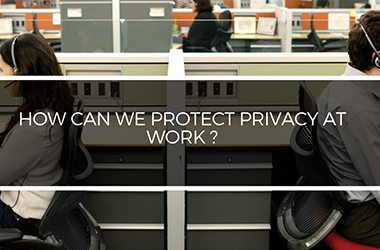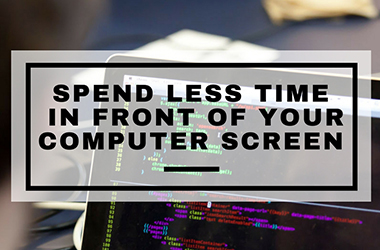With the increasing popularity of open-plan offices, getting some privacy at work is fast becoming a luxury. Studies show that privacy, wellbeing and our performance at work are closely intertwined. This is proven by employees all over the world – from London to Manchester, Paris to Brussels complaining that they are unable to concentrate on their work for various reasons, including untimely interruptions, colleagues constantly passing through the office, annoying sounds issuing from every direction, the printer churning out documents, people tapping away on their keyboards, the telephone always ringing… !
Why do we need privacy at work ?
In this era of collaborative work and group synergy that comes with having a shared office, there is a tendency towards dialogue and communication – which means that workers never get any privacy. A study conducted in 2014 by office furniture company Steelcase revealed that 95% of knowledge workers require more privacy and calm at work in order to be more efficient. Generally speaking, having no privacy at work has an impact on your employees’ involvement and engagement, whatever their job.
To optimise our concentration
At work, as in our everyday lives, we all need some time to ourselves to be able to work on complex projects which require a high level of concentration. But how is this possible when we’re being constantly interrupted ? On average, interruptions occur every 11 minutes and it takes us around 23 minutes to restore our concentration. That’s a lot of wasted time !
To relax
Employees may also need time to take a short, well-deserved break. We mustn’t forget that working constantly without a break is very demanding, both on our physical and mental health. When employees expend all their energy, they are putting their health and their ability to work effectively at risk : stress, fatigue and overwork will inevitably lead to burnout.
Why are open-plan offices to blame ?
As mentioned above, working in an open space deprives employees of the right to privacy and confidentiality. And that’s plain to see :
- Offices are cold and impersona l: personal items such as family photos and trinkets have completely vanished ;
- There is less space, making employees feel like sardines in a tin ;
- Employees feel like they’re being watched by their managers, or being spied on by their colleagues ;
- Whether you want to or not, you can’t help overhearing other people’s conversations.
As a result, employees feel like they’re under scrutiny and start to monitor their own behaviour. They may put up a more professional front and behave like a model employee all day, but in the long term, this can be exhausting and even frustrating.
What can we do about this lack of privacy ?
Due to not being able to be physically alone, some employees create an imaginary bubble by wearing headphones or earplugs or by hiding behind a pile of books…which isn’t great for communication.
If you’ve opted for open-plan offices in your workplace, you no doubt had good reason, so there’s no point switching back to enclosed offices. Besides, single-room offices also have their downsides, with most individuals who work in one reporting that they feel lonelier and isolated…so how can we tackle this constant dissatisfaction ?
The best solution is to find a compromise between personal spaces and collaborative spaces. How ? By simply rearranging your open-plan office into sections. You’ll also need to make provision for a meeting room. And last but not least, remember to create “rest areas” for employees to use freely. Decorating the space to make it more unusual can also be a good solution, so that each employee feels more at home, rather than in a dreary, impersonal environment.
Creating an intelligent open space
Divide your open-plan office into several sections (maximum 10 people per section). To do this, you can use storage furniture, such as shelves. This solution not only visually divides the space, but also enables employees to take ownership of their workstations, as they now have a private area where they can store their personal effects. This is important, since offices are almost a kind of living space (after all, employees spend most of their day there).
You could also go for removable partitions (especially for behind computer screens) or better still, soundproof partitions to reduce noise.
Furthermore, it’s essential to respect each employee’s personal space, which works out at about 12 to 15m2 per person. And finally, don’t forget that carpets absorb the noise of footsteps on the floor.
Making space for meeting rooms
It’s even possible to create a meeting room within an open-plan office – architects generally go for a cube shape with transparent walls. This allows the space to stay integrated with the rest of the room, while guaranteeing privacy and confidentiality inside. This way, employees can hold meetings or answer phone calls without disturbing their colleagues.
Creating a rest area
A break room is indispensable within a company – even more so if you’re in an open-plan office all day. Pick a well-lit, well-ventilated area where your employees can recharge their batteries in a pleasant environment. Add some decorative and comforting touches by plumping for footstools or sofas rather than chairs, and, if your budget permits, you could also add a mini-library or table football – and of course, a coffee machine.







 English
English  Français
Français  Nederlands
Nederlands